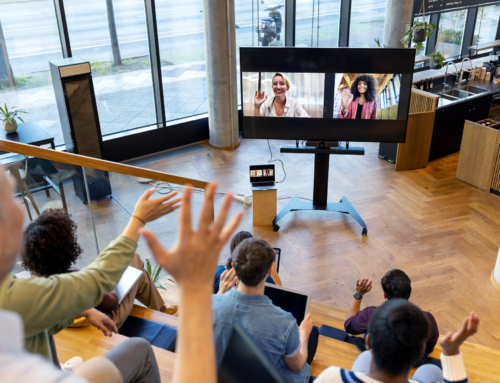“Immersion” is a buzzword you probably hear often. It’s popping up in articles, podcasts, trade shows, and conferences. The entire live event industry is talking about it.
What does “immersion” actually mean? And, more importantly, how do you harness immersion through neuroscience to engage and inspire event attendees?
Immersion means crafting events with a thoughtful blend of psychology, sensory engagement, and emotion to achieve your goals and engage your attendees.
I have recently been researching neuroscience with events. Here’s what I learned about how to create an immersive experience using neuroscience.

How to Create an Immersive Experience
Event stakeholders achieve strong immersion through production. But don’t start with the lights and music. Instead, know who your attendees are first.
Persona Creation
To create your ideal attendee persona, ask these important questions during the pre-phase of your event planning:
- Gain an understanding of your attendees’ needs, wants, and desires.
- What motivates them not only professionally but personally as well?
- Why did they register for the event in the first place?
Understanding attendee behavior allows the event planner to design an experience that aligns with how attendees engage, process, and retain information.
Be Aware of Your Demographics
Let’s consider two personas to illustrate how understanding your audience — and their minds — changes your program design.
Profile Example 1
Attendees who have a lot on their plates and may be pressed for time, plus being asked to juggle so many things, might be feeling overwhelmed:
Neuroscience insight: Create learning spaces and networking environments that balance engagement, sensory comfort, and focus.
Program design considerations: Facilitate engagement by making it easy to focus and connect with others:
- Create personalized name tags that highlight attendee motivators. This fosters connections, creates a sense of belonging, and helps individuals approach people they’ve never met.
- Use adaptive lighting systems, such as DMX, to adjust brightness and color based on a session’s needs. You’ll create more retention through effective lighting. For example, warm, dim lighting creates a relaxed, focused, and engaging atmosphere during networking events.
- Manage sound and background noise through directional sound and audio zones. Doing so eliminates areas where the music is so loud you can’t hear yourself speak. Audio zones focus the conversation around essential items.
Profile Example 2
Mid-career professionals focused on upskilling and gaining practical knowledge to apply to their roles.
Neuroscience insight: The brain absorbs and retains information better when participants engage actively with content rather than passively consuming it.
Program design considerations: Most conference attendees fall into this category, so find ways to inspire and energize this group:
- Inspire your attendees before the general session and during breaks with interactive touchscreen kiosks. This allows them to interact with content and connect with speakers, leaders, and peers.
- Increase interaction through touch tables and selfie walls.
- Boost interactivity even more through interactive learning sessions, like audience response systems (ARS), which empower participants to respond to questions, polls, and surveys in real-time using tablets or smartphones.
Filling Attendees’ Dopamine Tanks
To understand what fills an attendee’s dopamine tank, identify the elements of an event or experience that stimulate excitement, joy, and motivation.
According to neuroscience, the brain rewards us for encountering new information. That means uncommon and surprising experiences release dopamine.
Fill attendees’ dopamine tanks by creating engaging, enjoyable, and emotionally resonant experiences. Use that dopamine to enhance attendees’ satisfaction and create memorable experiences that boost engagement, brand loyalty, and recognition.
To implement this idea:
- Introduce unexpected elements, such as surprise guest speakers, interactive activities during coffee breaks, or unique entertainment. For example, feature an unannounced performance at your conference.
- Create tailored experiences to enhance emotional engagement. For instance, during IMEX, one of our clients filled her dopamine tank by playing pickleball — one of her favorite games — between sessions.
- Encourage social interaction through activities that foster connections and create a sense of belonging.
- Evoke all five senses to drive engagement. Not everybody gets a dopamine kick from what they see — some people need sounds, smells, and activities to learn.
- Elicit laughter and excitement. Everybody likes to have fun!
- Cultivate exclusive experiences that one will not experience on their own.
- Involve competition and gamification (particularly useful for engaging attendees at sales meetings).
- Provide recognition and positive feedback for excellent work.
Understanding the psychology behind these elements will allow you to design events that meet and exceed attendees’ expectations. So, be sure to fully understand your audience!

How to Create an Immersive Experience: Practical Ideas
Now that you know who’s attending your event and understand dopamine’s role in event curation, you’re ready to learn how to create an immersive experience.
Unfortunately, there’s no step-by-step guide to crafting the perfect immersive event. But you can guide your planning process by keeping a few neuroscience-inspired elements in mind.
Journey Design
Create a full journey that engages attendees from beginning to end so that they feel like a movie star, not an extra. Consider how you’ll build anticipation, reach a climax, and settle into a resolution within the event.
Emotional Triggers
Decide what emotional triggers you want to evoke at your event, then design interactions that elicit those feelings. For example, one of our clients loves joy, which comes through in all their content, branding, and events.
Maybe you want to energize or inspire attendees. Or, if you struggle with retention, you might want to evoke commitment.
Immersive Spaces
Create a setting that transforms physical space into an immersive environment. This can involve unusual locations, creative set design, or even outdoor spaces that blend with nature.
Ambiance and Vibe
Control an event’s atmosphere using lighting, temperature, and sound design.
If you want your surveys to soar, build powerful, dynamic visuals into your budget. Visual elements improve engagement, memory, and retention and elevate the event’s impact.
Projection mapping or LED walls are great examples. Dynamic visuals with lighting design set the mood, direct focus, and evoke emotion.
Sensory Engagement
Connect emotionally with attendees by appealing to all five senses. Lighting, sounds, scents, and textures help participants feel fully present.
Sound in particular is crucial. Harness music and audio effects to set the mood or create themed zones. For example, you might use futuristic electronic music to get participants in the right headspace, while calming nature soundscapes might be more appropriate for a sustainability session.
Signature sounds enforce brand identity and evoke emotion. For instance, play the CEO’s favorite song when they walk on stage. Or, if you want to invoke joy at a sales meeting, play upbeat music.
Interactive Elements
Encourage participants to engage with their environment through touch, movement, or interaction. This creates a more memorable emotional impact.
AR and VR: The Future of Immersion
Augmented reality (AR) and virtual reality (VR) are taking off in the event industry. We’ll harness these tools for education and engagement in the near future.
InnoVia is scaling up its use of AR and VR. To ensure you’re ready for the upgrade, let’s explore how to use them to create an immersive experience.
AR
Augmented reality adds to the real world without replacing it.
Using AR for meetings enhances the experience by overlaying digital content onto the physical world. This makes collaboration, communication, and creativity more interactive and engaging.
For example, imagine projecting a 3D model of the human heart onto a conference table or screen during a medical product launch. With AR technology, attendees can interact with the model, zoom in, and observe how the product presented interacts with the muscle and blood vessels.
AR allows stakeholders to see how products fit into real-world scenarios without needing a physical prototype — and that’s just one use case!
VR
Virtual reality uses headsets and other immersion-increasing devices to replace the real world with a virtual one. Attendees can interact with and explore digital spaces like real life.
Imagine a life sciences company showcasing a new medical device in a simulated operating room or laboratory. Attendees can fully immerse themselves in the environment and gain (digital) hands-on experience in a realistic, engaging way.
VR offers an advantage over static images or videos. Stakeholders will have a more impactful and memorable experience exploring a design and seeing how it fits into their workflows.
How to Integrate AR and VR
AR and VR will blow your stakeholders away — but don’t overwhelm them with these emerging technologies. They aren’t blanket solutions you can roll out instead of what you’ve already carefully built.
Follow these strategies to effectively integrate AR and VR into your immersion strategy:
- Be intentional and have a clear purpose
- Keep VR and AR use simple and intuitive
- Focus on storytelling
- Limit sensory overload
- Create a modular experience
How to Create an Immersive Experience: Final Thoughts
If you want to know how to create an immersive experience, understand the people you’re trying to reach and create experiences they’ll resonate with.
Our experienced project managers can offer the production support you need to exceed expectations and create immersive experiences for attendees. Contact us today to get started.






